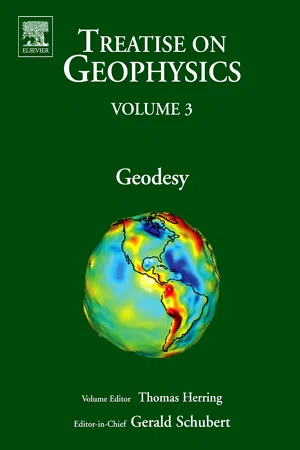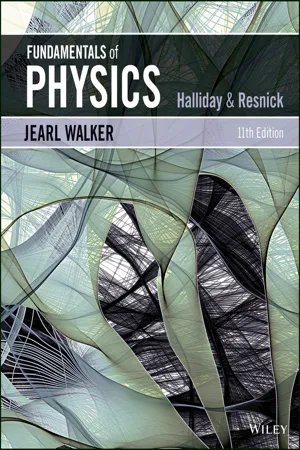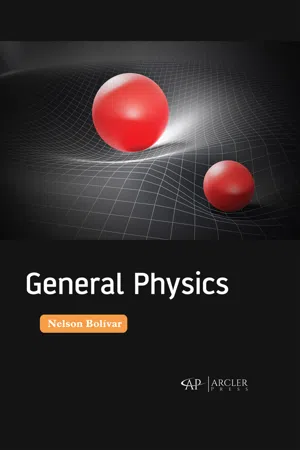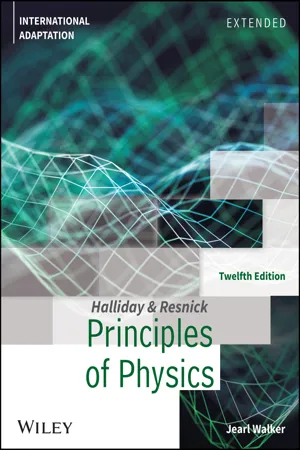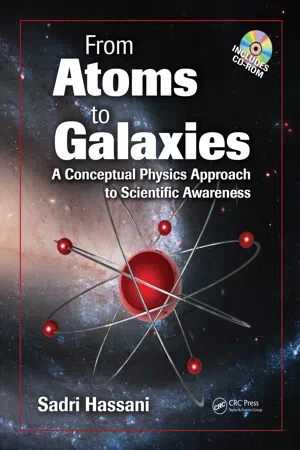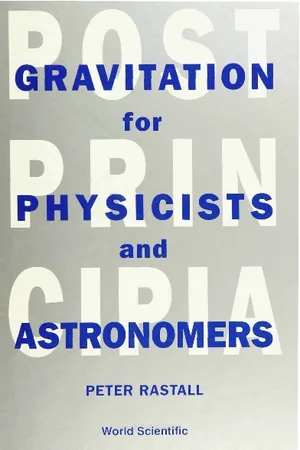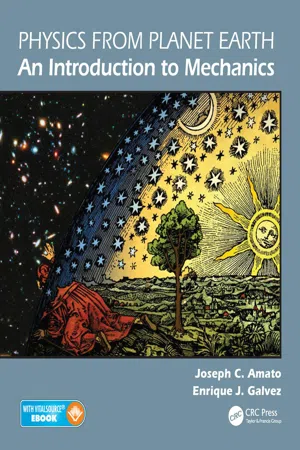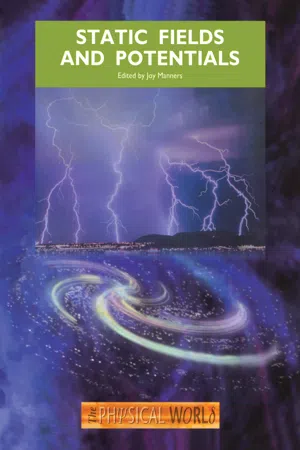Physics
Gravitational Potential
Gravitational potential is a measure of the potential energy per unit mass at a given point in a gravitational field. It represents the work that would be done in moving a unit mass from a reference point to the point in question. The gravitational potential is a scalar quantity and is used to calculate the gravitational potential energy of an object in a gravitational field.
Written by Perlego with AI-assistance
Related key terms
1 of 5
11 Key excerpts on "Gravitational Potential"
- eBook - PDF
- Tom Herring(Author)
- 2010(Publication Date)
- Elsevier(Publisher)
Under this precept, the geometry of space is defined intrinsically by the gravitational fields contained therein. We continue with the classical Newtonian poten-tial, but interpret gravitation as an acceleration different from the acceleration induced by real, applied forces. This becomes especially important when considering the measurement of gravitation (Section 2.6.1). The Gravitational Potential, V , is a ‘scalar’ function, and, as defined here, V is derived directly on the basis of Newton’s law of gravitation. To make it completely consistent with this law and thus declare it a Newtonian potential, we must impose the following conditions: lim , !1 , V ¼ Gm and lim , !1 V ¼ 0 ½ 10 Here, m is the attracting mass, and we say that the potential is regular at infinity. It is easy to show that the Gravitational Potential at any point in space due to a point mass, in order to satisfy eqns [8]–[10], must be V ¼ Gm , ½ 11 where, again, , is the distance between the mass and the point at which the potential is expressed. Note that V for , ¼ 0 does not exist in this case; that is, the field of a point mass has a singularity. We use here the convention that the potential is always positive (in contrast to physics, where it is usually defined to be negative, conceptually closer to poten-tial energy). Applying the law of superposition, the gravita-tional potential of many point masses is the sum of the potentials of the individual points (see Figure 4 ): V P ¼ G X j m j , j ½ 12 And, for infinitely many points in a closed, bounded region with infinitesimally small masses, d m , the summation in eqn [12] changes to an integration, V P ¼ G Z mass d m , ½ 13 or, changing variables (i.e., units), d m ¼ & d v , where & represents density (mass per volume) and d v is a volume element, we have ( Figure 5 ) 16 Potential Theory and Static Gravity Field of the Earth - eBook - PDF
- David Halliday, Robert Resnick, Jearl Walker(Authors)
- 2018(Publication Date)
- Wiley(Publisher)
The force would then reach a maximum at a certain depth, and only then would it begin to decrease as the capsule further descends. 13-5 Gravitational Potential ENERGY 13.11 Calculate the Gravitational Potential energy of a system of particles (or uniform spheres that can be treated as particles). 13.12 Identify that if a particle moves from an initial point to a final point while experiencing a gravita- tional force, the work done by that force (and thus the change in Gravitational Potential energy) is indepen- dent of which path is taken. 13.13 Using the gravitational force on a particle near an astronomical body (or some second body that is fixed in place), calculate the work done by the force when the body moves. 13.14 Apply the conservation of mechanical energy (including Gravitational Potential energy) to a particle moving relative to an astronomical body (or some sec- ond body that is fixed in place). 13.15 Explain the energy requirements for a particle to escape from an astronomical body (usually assumed to be a uniform sphere). 13.16 Calculate the escape speed of a particle in leaving an astronomical body. Learning Objectives After reading this module, you should be able to . . . Gravitational Potential Energy In Module 8-1, we discussed the Gravitational Potential energy of a particle – Earth system. We were careful to keep the particle near Earth’s surface, so that we could regard the gravitational force as constant. We then chose some reference configuration of the system as having a Gravitational Potential energy of zero. Often, in this configuration the particle was on Earth’s surface. For particles not 365 13-5 Gravitational Potential ENERGY on Earth’s surface, the Gravitational Potential energy decreased when the separa- tion between the particle and Earth decreased. Here, we broaden our view and consider the Gravitational Potential energy U of two particles, of masses m and M, separated by a distance r. - eBook - PDF
- Nelson Bolívar(Author)
- 2020(Publication Date)
- Arcler Press(Publisher)
General Physics 122 Ug = Fg ⋅ h = m ⋅ g ⋅ h Figure 5.4. A weight lifted vertically to acquire Gravitational Potential energy. Source: https://www.tes.com/lessons/PQ4Nky_diwdIrA/potential-and-kinetic-energy. The object would fall back down to the ground if the force was to be removed and the Gravitational Potential energy would be changed into kinetic energy of the falling object. Our artifact on conservation of energy contains some example problems that are solved over knowledge of how Gravitational Potential energy is transformed into other forms (Manga and Kirchner, 2004; McKenzie and Jackson, 2012). What is exciting about Gravitational Potential energy is that we can choose the zero arbitrarily. In other words, we have the freedom to select any vertical level as the location where h = 0. For simple mechanics problems, a suitable zero point would be at the surface of a table or on the floor of the laboratory. In principle nevertheless, we could select any orientation point— sometimes called a datum . If the object were to pass below the zero points, the Gravitational Potential energy could even be negative. This doesn’t present a problem, however; we just have to be certain that the same zero points are used constantly in the calculation (Flesch et al., 2007; Schmalholz et al., 2014). Work, Energy, and Power 123 Exercise 5.2: How much electrical energy would be used by an elevator lifting a 75 kg person through a height of 50 m if the elevator system has an overall efficiency of 25%? Assume the mass of the empty elevator car is properly balanced by a counterweight (Figure 5.5). Figure 5.5. Schematic of an elevator system. Source: https://www.khanacademy.org/science/physics/work-and-energy/work-and-energy-tutorial/a/what-is-gravitational-potential-energy. Electrical energy through the grid is transferred into the Gravitational Potential energy of the heat and person because of friction inside the elevator system. - David Halliday, Robert Resnick, Jearl Walker(Authors)
- 2023(Publication Date)
- Wiley(Publisher)
Similarly, in Module 13.7 we shall speak of “the potential energy of an artificial satellite” orbiting Earth, because the satellite’s mass is so much smaller than Earth’s mass. When we speak of the potential energy of bodies of comparable mass, however, we have to be careful to treat them as a system. Multiple Particles. If our system contains more than two particles, we consider each pair of particles in turn, calculate the Gravitational Potential energy of that pair with Eq. 13.5.1 as if the other particles were not there, and then algebraically sum the results. Applying Eq. 13.5.1 to each of the three pairs of Fig. 13.5.1, for example, gives the potential energy of the system as U = − ( Gm 1 m 2 ________ r 12 + Gm 1 m 3 ________ r 13 + Gm 2 m 3 ________ r 23 ) . (13.5.2) Proof of Equation 13.5.1 Let us shoot a baseball directly away from Earth along the path in Fig. 13.5.2. We want to find an expression for the Gravitational Potential energy U of the ball at point P along its path, at radial distance R from Earth’s center. To do so, we first find the work W done on the ball by the gravitational force as the ball travels from point P to a great (infinite) distance from Earth. Because the gravitational force F → (r) is a variable force (its magnitude depends on r), we must use the tech- niques of Module 7.5 to find the work. In vector notation, we can write W = R ∞ F → (r) ⋅ d r → . (13.5.3) The integral contains the scalar (or dot) product of the force F → (r) and the differential displacement vector d r → along the ball’s path. We can expand that product as F → (r) ⋅ d r → = F(r) dr cos ϕ, (13.5.4) where is the angle between the directions of F → (r) and d r → . When we substitute 180° for and Eq. 13.1.1 for F(r), Eq. 13.5.4 becomes F → (r) ⋅ d r → = − GMm ______ r 2 dr, where M is Earth’s mass and m is the mass of the ball.- No longer available |Learn more
Physics for Scientists and Engineers
Foundations and Connections, Extended Version with Modern Physics
- Debora Katz(Author)
- 2016(Publication Date)
- Cengage Learning EMEA(Publisher)
UNIVERSAL Gravitational Potential ENERGY ▲ Special Case The subscript G is a reminder that Equation 8.7 is good for particles that interact through (universal) gravity. Plotting Universal Gravitational Potential Energy EXAMPLE 8.5 Plot U G 1r 2 versus r and show with a sketch how it connects to a spacecraft moving directly away from the Earth. Should the change in the system’s Gravitational Potential energy be positive, negative, or zero? Does the graph give the predicted results for DU G ? INTERPRET and ANTICIPATE We put r on the horizontal axis and U G 1r 2 on the vertical axis (Fig. 8.14). It may be helpful to use a spreadsheet or similar program. Our sketch shows the Earth and the spacecraft at two different positions r u 1 and r u 2 . Because the spacecraft moves away from the Earth, we expect that the system’s Gravitational Potential energy will increase: DU G . 0. SOLVE From the graph, U G 1r 2 2 . U G 1r 1 2 . Therefore the change in potential energy if the spacecraft moves away from the Earth from r u 1 to r u 2 is positive, which means that the Gravitational Potential energy increases as the spacecraft moves away. DU G 5 U G 1r 2 2 2 U G 1r 1 2 U G 1r 2 2 . U G 1r 1 2 DU G . 0 CHECK and THINK The graph shows that as r S ` , the potential energy U G S 0 as required by our choice of the usual reference configuration. R { r 1 R { U G r 2 r r 2 u r 1 u FIGURE 8.14 8-5 Elastic Potential Energy The other conservative force we study in mechanics is exerted by a spring that obeys Hooke’s law. In this section, we derive an expression for the potential energy stored by such a spring, which is known as elastic potential energy. ELASTIC POTENTIAL ENERGY ▲ Special Case Figure 8.15 shows a block on a frictionless, horizontal surface attached to a spring. The other end of the spring is attached to a fixed wall. The system consists of the block, the spring, and the wall. For brevity, we omit the wall and refer to the system as a spring–block system. - eBook - PDF
- Rodney Hill(Author)
- 2016(Publication Date)
- Pergamon(Publisher)
In fact, the accelerations of the mass-centres usually depend as well on the orientations and possible distortions of all bodies. ].14] Gravitational Potential A N D POTENTIAL ENERGY 37 / / p a p = -grad^rf//, (3) alternatively to (6) in §1.13. The total potential φ is to be sharply distinguished from the total potential energy V (the clash in terminology being unfortunate, but firmly established). ^ is a function of the independent variable r as well as the entire mass-configuration, while V has to do only with the latter and is defined as an overall integral: pairs PQ | ( r p -r p ) + ( p -p ' ) φαμ (4) where <^ in a typical body Q is given by (2) with r = TQ + ρ'. The factor I is needed in the second expression for V since a typical inverse distance (say between αμ and αμ' in bodies Ρ and Q) appears twice: once in the integral over Ρ of the part of φ due to Q and again in the integral over Q of the part of φ due to P. For future reference we note, in passing, a variation formula: Σ ίδ (τ + ρ)αμ + δν = 0 (5) ν Ρ for arbitrary infinitesimal changes in the geometry (including shapes and orientations). This may be proved most conveniently by com-puting the variation of the integrand in the first expression for V, coupled with the observation that the range of integration over the mass distribution obviously does not alter even though the positions and shapes of material elements may do. With the special choice of variations such that the bodies are merely translated indepen-dently, without rotation or distortion, á (r + ρ) = δτρ throughout body Ρ for example and (5) becomes Σ(μαδτ)ρ + dV = 0 (6) with the help of (3) in §1.13. This generalizes a similar result, (9) in §1.6, for mass-points. This is just the sum of the potentials of the individual fields (in-cluding the self-field of any body containing the point r). From (3) of §1.13 the equation of motion of a typical mass-centre is given by - eBook - PDF
From Atoms to Galaxies
A Conceptual Physics Approach to Scientific Awareness
- Sadri Hassani(Author)
- 2010(Publication Date)
- CRC Press(Publisher)
Gravitational Constant The universal physical constant G setting the scale of the strength of the gravitational force. Gravitational Field The physical entity surrounding any massive body. A test object introduced in this field experiences the gravitational force exerted by the massive body. Gravitational Potential Energy The energy related to the work done by gravity. More precisely, the work done by gravity in taking a test object from an initial position to a final position is the difference between the potential energies at those two points. Quantization The process of reconciling a classically observed force with the quantum theory. Standard Model The theory that explains three of the four fundamental forces of nature: electromagnetism, weak nuclear force, and strong nuclear force. Super Force The Holy Grail of fundamental physics. It is the single force which encom-passes all the fundamental forces of nature, including gravity. Universal Law of Gravitation The mathematical formula giving the gravitational force between two objects in terms of their masses and the distance between them. Weightlessness The condition prevailing in a freely-falling enclosure under which objects in the enclosure float. 148 Chapter 9 Gravitation 9.4.3 Review Questions 9.1. Name all the fundamental forces of nature. How well is gravity understood? At what level? 9.2. Did Newton discover gravity? If not, why is his name associated with gravity? 9.3. What is common between an apple falling down and the Moon going around the Earth? Who saw this commonality? 9.4. Who measured the universal gravitational constant? When did he do it? How many years after Newton discovered the law of gravity? Why was the measurement touted as “weighing the Earth?” 9.5. What is dark matter? Can we see it? If not, how do we know that it even exists? Which law is used to confirm the existence of dark matter? Where do we find it? 9.6. - eBook - PDF
Postprincipia: Gravitation For Physicists And Astronomers
Gravitation for Physicists and Astronomers
- Peter Rastall(Author)
- 1991(Publication Date)
- World Scientific(Publisher)
In other words, when r = 1 the kinetic energy contributes to the weight in the same way as the energy of a stationary particle. We emphasize that we are concerned with a system whose centre of mass is at rest in a static gravitational field. Putting r = —A = 1 in (3.3), we find that the passive gravitational energy in Newtonian units of the ■particles only is J/a = £ + £ m V h 2 = (£ + 3Bp). (3.4) b 4. Energy of the gravitational field The gravitational field is, so far, no more than a convenient device for calculating gravitational forces. We recall that the electric field played a similar role in elec-trostatics, but that it soon found other uses - first as a place to store the electric potential energy, and then in the description of electromagnetic waves. 3 A similar development in Newtonian gravity was halted when it was shown that the energy density of the gravitational field is negative. In a strictly static theory this would not matter, but as soon as there is any time dependence a system will presumably evolve to states of lower energy. Since there is no state of lowest energy - the gravitational energy can take arbitrary negative values - the system cannot attain equilibrium and singularities will develop. We must now see whether the same difficulty arises in gravitostatics. Let us first recall some earlier terminology and results. We have defined the gravitational field to be — V, where is the dimensionless potential. The gravitational force on a stationary particle of energy E is —EV(Z, .), where Z = (Z 1 , Z 2 , Z 3 ) are the coordinates of the particle in a ^> 0 frame. For a particle of velocity V = DZ, the gravitational force is -E[l+V 2 cJf 2 ]V(j>(Z, .), from 111(4.6) with V 2 = V 2 (we are using the standard values 111(3.6) of the parameters A, T, and n). When is static (d t ^> = 0) and only gravitational forces act on the particle, the quantity E = mc 2 N j is a constant of the motion. - Joseph C. Amato, Enrique J. Galvez(Authors)
- 2015(Publication Date)
- CRC Press(Publisher)
When the body undergoes a displacement dr I , it feels a force that is always antiparallel to dr I . Is this a conservative force? 10.3 Gravitational Potential ENERGY We can now use Equation 10.1 to derive the Gravitational Potential energy function U r ( ). I First let’s express I F in vector form. Let I r xi y j zk = + + be the location of m relative to M , and define a unit vector r parallel to the position vector I r (see Figure 10.1b ): r r r xi y j zk x y z I = = + + + + 2 2 2 . In the following discussion, we will dispense with the coordinate axes and write all of our mathematics in terms of I r and r . Because m is attracted toward M , the force on m is in the r direction (i.e., antiparallel to r ), so the magnitude and direction of I F can be expressed in vector form as I I F r GMm r r ( ) . = − 2 (10.2) Once again consider the work done along Path 1 in Figure 10.1a . Since W p → f = 0, Equation 10.1 tells us that U r U r p f ( ) ( ). I I = More generally, U r ( ) I has the same value at all points equidistant from M . This set of points forms a circle in 2D, or a spherical shell in 3D, centered on M . In other words, U r ( ) I depends only on the magnitude of I r and not on its direction: U r U r ( ) ( ) I = . To evaluate W i → f along any path joining points i and f , it is sufficient to calculate the work done on a radial path that starts at a distance r i from M and moves radially away to a distance r f from M (e.g., points i and p in Figure 10.1a ). From Equations 10.1 and 10.2 , the change in potential energy is U r U r W GMm r r dr f i i f r r i f ( ) ( ) . − = − = − − ⋅ → ∫ 2 I Chapter 10 – Gravitational Potential Energy and Orbital Motion 381 When evaluating this line integral, there are a number of minus signs to keep straight, so let’s proceed cau -tiously. If r f > r i , the vectors r and dr I are parallel, dr > 0, and r dr r dr dr dr I ⋅ = ⋅ = = | | | |cos | | .- eBook - PDF
- Richard C. Hill, Kirstie Plantenberg(Authors)
- 2013(Publication Date)
- SDC Publications(Publisher)
30 7.5.2) Gravitational Potential energy................................................................................................. 30 7.5.3) Elastic potential energy .......................................................................................................... 33 7.6) WORK-ENERGY BALANCE & CONSERVATION OF ENERGY ................................. 36 7.6.1) The work-energy balance equation ........................................................................................ 36 7.6.2) Conservation of energy .......................................................................................................... 37 7.7) WORK-ENERGY FOR A SYSTEM OF PARTICLES .................................................... 44 7.7.1) Work ....................................................................................................................................... 45 7.7.2) Kinetic and potential energy ................................................................................................... 45 7.7.3) Work-energy balance ............................................................................................................. 46 7.8) POWER AND EFFICIENCY .......................................................................................... 51 7.8.1) Power ..................................................................................................................................... 51 7.8.2) Efficiency ................................................................................................................................ 53 CHAPTER 7 REVIEW PROBLEMS ..................................................................................... 56 CHAPTER 7 PROBLEMS .................................................................................................... 63 CHAPTER 7 COMPUTER PROBLEMS ............................................................................... - eBook - ePub
- Joy Manners(Author)
- 2020(Publication Date)
- CRC Press(Publisher)
equipotential.Figure 2.12 (a) A contour map of a mountain, and (b) a cross-section along line XY of the same mountain. The slope is steepest where the contour lines are closest together.Equipotentials
These results are not restricted to the gravitational field. Imagine two point charges q1 and q2 separated by a distance R. Suppose q1 is held fixed at the origin, but q2 may be moved. We know from Section 3.2 that the potential due to q1 is:VEqn 2.11( r )=.q 14 πε 0rSince the electric field and potential due to a point charge are spherically symmetric, that is, the same in all directions, V depends only on the magnitude of r, not its direction, so we can write simplyV( r )=.q 14 πε 0rAt the location of q2 , where r = R, the potential due to q1 is V(R), so the potential energy of q2 is q2 V(R). Moreover, q2 may be moved from its initial position to any other point on the surface of an imaginary sphere of radius R, centred on q1 without any change in the energy of the system. All the points on this imaginary sphere are therefore at the same potential: the sphere describes an equipotential surface. Figure 2.13 shows spherical equipotential surfaces around a charge of 10−1 C at 1, 2, 3, 4 and 5 V (assuming V = 0 at infinity).Figure 2.13
Index pages curate the most relevant extracts from our library of academic textbooks. They’ve been created using an in-house natural language model (NLM), each adding context and meaning to key research topics.
